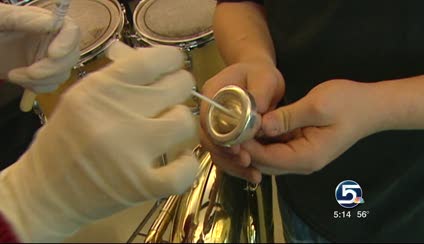Estimated read time: 3-4 minutes
This archived news story is available only for your personal, non-commercial use. Information in the story may be outdated or superseded by additional information. Reading or replaying the story in its archived form does not constitute a republication of the story.
SALT LAKE CITY -- Thousands of kids across Utah play wind instruments, but each time they blow their horns they leave behind a trail of spit and germs.
A recent national study found some pretty nasty stuff lurking inside those instruments that could make musicians sick. So we put some Utah horns to the test to see if your child's hobby could make them ill.
Soda, food, gum -- some teens are not the best at taking care of their instruments. Highland High School senior Wynter Powell knows a kid who never cleans his saxophone.
- 20 per sample mouthpiece trumpet
- >5,000 per sample valve trumpet
- 4,210 per sample mouthpiece clarinet
- >5,000 per sample middle of clarinet
- 320 per sample tuba mouthpiece
- 470 per sample tuba valve
- 80 per sample trombone valve
- 2820 per sample trombone mouthpiece
- 10 per sample trumpet valve
- 20 per sample trumpet mouth
- No growth across the board clarinet middle
- 150 per sample clarinet mouthpiece
"Behind the reed, in the black mouthpiece, it was completely green, it was molded, it was horrible," said Powell.
Speaking of green, it's the color of a spot on the band room carpet at Murray High. "It's been there for a very long time," said junior Easton Francis.
It's where Francis cleans out the spit valve on the school trombone, now losing its silver finish. "It creates the illusion that it's extremely dirty," said Francis.
We thought we'd see just how dirty. We swabbed four instruments between the two bands.
We tested a clarinet for sale for $139 on KSL classifieds. The owner says it is brand new, from China. And we tested a trumpet from Summerhays Music in Murray. President Scott Summerhays says it rents thousands of band instruments a year.
"Any time something encounters the human mouth, there's a chance that bacteria could be bred," said Summerhays.
The Summerhays trumpet had the least amount of bacteria. It takes each instrument apart and puts it in a special chem clean bath. Next cleanest was the new clarinet on ksl.com. Then came the Tuba at Murray with 790 bacteria per sample, the trombone had 2,900. At Highland, the trumpet and clarinet each had a bacteria count of more than 5,000.
Band member Jeffery Lingen expected it.
"There's a lot of bacteria in the world," said Lingen.
None of the Utah samples tested positive for major problems but a national study by researchers from Oklahoma State University Center for Health Sciences found instruments with staph and E-coli. The experts say what we found shows anyone playing an instrument should just clean it more often.
- When sharing an instrument, have your own mouthpiece
- Take the instrument to a music store for periodic cleaning
- If you own the instrument, wipe it down with soap and water after each use
"They will have better success and enjoy it more," said Summerhays.
Our lab researchers said, "One of the most important findings to stress is that no staph or E. coli were found. These numbers mean the higher the count, the higher the chances that some of those ‘bugs' will be of the type to make you sick. However, since we did not find staph or E. coli, more than likely those high numbers are types of bacteria typically found on people and do not necessarily pose a threat for illness.
"If we had found staph, for instance, some strains are more infectious than others and some people may be more susceptible to these strains."
On the other hand, a bacteria count greater than 5,000 indicates the surfaces are not being cleaned properly and can have the potential to include viruses and other infectious bacteria.
E-mail: mrichards@ksl.com








